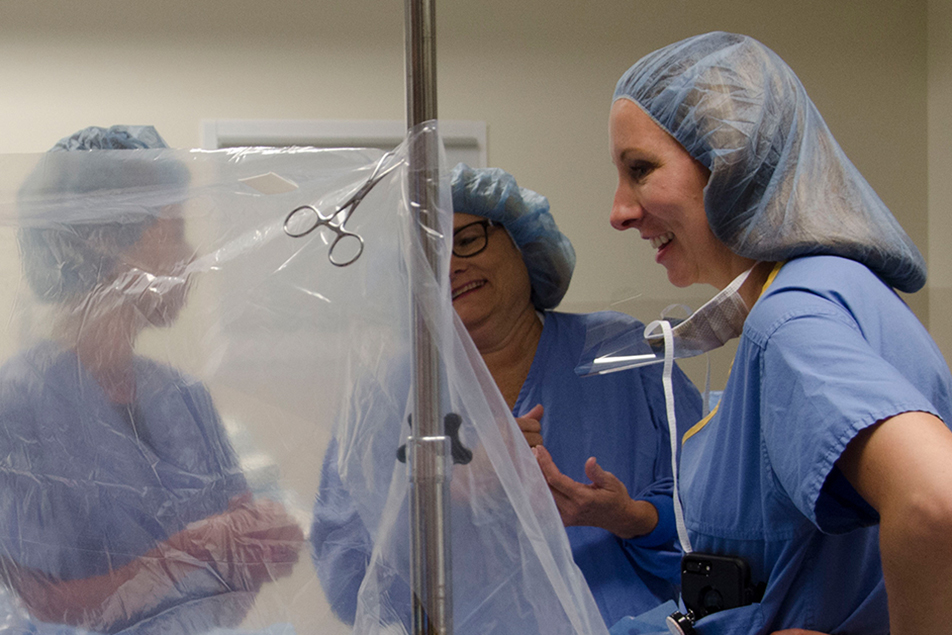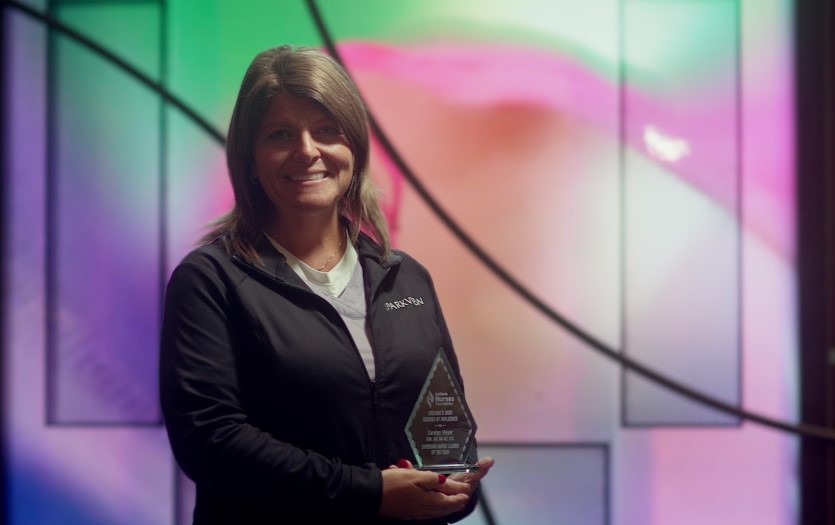

This post was written by Courtney Leach, digital/social media manager, Parkview Health.
In a hospital, so often the events of a day revolve around just one breath. One breath on their own, one breath of relief, one final breath, and, in a particularly disarming corner of the hospital, one first breath. This dramatic inhalation in particular is followed by the much-anticipated encounter of two souls who’ve been attached for months, but are only now meeting.
It’s a phenomenon I witnessed for myself last week, when I spent the day shadowing Jody Freyre, MD, PPG – OB/GYN, Hospital Medicine, a hospitalist at Parkview Regional Medical Center. Our time together came just two weeks after her return from maternity leave; a return celebrated by her colleagues and team frequently throughout the interactions of the day. (For the record, she says she was a terrible patient.)
I arrived as she was going through the daily exchange of care with Mychelle Owen, DO, PPG – OB/GYN, Hospital Medicine, another member of her team. The hospitalist concept was implemented in July 2016 to offer full time coverage to patients staying at the facility in lieu of the traditional doctor-on-call model. The results and unexpected benefits have been impressive, to say the least.
Each of the five physicians in this position covers approximately seven 24-hour shifts each month, meaning someone is always available. While an entire day of work seems intimidating to a non-clinical observer, it’s nothing unusual for the group. “Oh, we’re used to it!” Dr. Freyre would later tell me. “We want someone to always be here. We need to be here. The NICU will tell you, we’re seeing better outcomes. We have a lower C-section rate, for example, because we’re not in a rush. We have time to wait and make the best decision.” In fact, the hospitalists’ presence in the OB area has meant faster response to treating hemorrhage, bleeding, infection and hypertension as well.
During their morning meeting, Dr. Freyre went meticulously through the list of antepartum patients on the floor, jotting down notes and asking additional questions for clarification, as a constant fury of alarms and phones rang behind her. She would carry these notes with her the rest of the day. They would be her guidebook, her atlas.
Once the briefing was complete, she walked over to me and introduced herself. She was warm and inviting and contagiously enthusiastic. All before 8 a.m. “Room 10 is at 1 centimeter,” one of the nurses mentioned over the desk at the nurses’ station. It was the first of countless increments of progression I would hear in the hours to come. Dr. Freyre was joined by Megan Lemon, a family medicine resident. We would be her entourage for the day, and it was time to get the shift started.
We began by rounding on patients, checking in on some of the more critical cases first. On a busy day, this process can take Dr. Freyre until midnight, as deliveries and triage cases present and demand her attention. The women in these rooms are often facing situations that require long-term care, namely, an early labor, high blood pressure, or other high-risk complications. These also tend to be the women Dr. Freyre and her fellow hospitalists develop the closest connections with. “We all had practices in our past lives,” she said. “And sometimes you miss having those relationships with your patients. But now, these ladies are the ones I’m forming those bonds with. I see some of them every three days, sometimes for weeks straight.”
One at a time, working through her list, she’d give a quick tap on the door and slowly ease into the dark rooms. The ladies, not quite awake, more often than not cast in the faint white glow of a television, would turn their heads and face the responsibility of another day of mandatory patience. In each room, at each bedside, case after case, Dr. Freyre came alongside the women and immersed herself in their journey. She would review their chart and their labs, talk through the results with them, and then crouch down to look into their eyes as she delivered the possible scenarios to come with a soft transparency.
Their comfort with her was palpable. Her bedside manner is a perfect blend of confidence and compassion. “I’m so happy you’re still here! And still pregnant!” she said to one long-term patient. “I’ve been praying for you.” Her tendencies to express genuine concern are punctuated by a wealth of compliments. She was handing them out all day … “I love your nails!” “Nice lipstick.” “That color is great on you.”
But I’d argue it’s Dr. Freyre’s humor – the playful garnish to her exchanges – that solidifies her special rapport with people. At one point, after vocalizing her excitement over new wireless monitors, she turned toward the patient and quipped, “I bet this is really comforting for you right now, huh? That I’ve never seen this thing that’s attached to you before.” The room dissolved into laughter.
The fact that she maintains such a light demeanor is impressive when you consider the demands of her role. Dr. Freyre is fiercely dedicated to delivering a thorough interaction, always mindful of the unique risks that accompany each mother. For example, if a patient has high blood pressure, that puts them at risk of a stroke. If a patient’s water broke early, Dr. Freyre is watching for labor, abruption or infection, all of which require immediate action. While the amount of medical information and scenarios coming at mothers-to-be can be overwhelming, the hospitalists strive to ease their fears. “I’m here to put it all together for you. That’s my job,” she said.
Dr. Freyre stopped by a nearby computer to update a chart, which, I mentioned always seems to be the task clinical professionals dread most. “You know, I don’t mind it,” she said. “In this situation, it’s so important. Communication is essential.” That communication between the network of OB/GYN physicians and the team of hospitalists is ever-evolving, and now, one year into the program, impressively strong. “We have a great deal of respect for what they do,” Dr. Freyre said. “And they wanted to be sure we were going to take great care of their patients, which they’ve seen. I think we’re in a really great place now.”
The clear communication is key to the success of the hospitalist program. As we worked our way through the active labor rooms, Dr. Freyre was very deliberate about addressing the status of each patient’s primary care provider, including their availability, how she was updating them on the latest developments, and the role she would play if their OB doctor was not available by delivery time. Maintaining that connection between the patient and their physician is a pillar of the hospitalist initiative.
After seeing a triage and an ER patient, one in false labor and the other recovering from an ectopic pregnancy, I asked Dr. Freyre how she handles the unique sensitivity this role requires. How do you help the women who won’t be able to bring their baby home? “It’s tough. I always just try to be kind and give them hope,” she said. “This community is fortunate, too, in that Parkview offers care for mothers who experience the loss of a baby.” It’s the outcome no patient or caregiver wants to see, but even medicine has its limits. “I appreciate the people around me. So, I know no matter what, we did everything we could. But I also respect nature.”
We stopped into Room 10. The laboring woman was joined by several family members, eagerly awaiting the arrival of her first baby. Dr. Freyre looked at the strip outlining her contractions, the baby’s heart rate and her medical history. “First babies can take some time. It will probably be early tomorrow, OK? Hang in there.” The young woman nodded, breathing deeply through her discomfort and the possibility of more of it.
On most days, every room in the labor and delivery unit is full. Each month, approximately 230 babies are delivered at Parkview Regional Medical Center alone, which makes for a constant stream of dramatic narratives unfolding in real time. Each arrival its own heroic tale. Stand outside the door of any suite and you’ll experience all the elements of literature’s finest stories – setting the scene, the rising action, the climax, the falling action and the resolution – all taking place within hours. Act after act, the nurses are there, coaching, consoling, encouraging. It’s a staggering illustration of triumph and of joy and of the pain of loving something so much.
As we left Room 10, a nurse toward the end of the hall approached Dr. Freyre. Her calm insistence signaled my host to quicken her steps. There was a baby coming, soon. The patient’s doctor, Lindsay Coda, DO, PPG – OB/GYN, was five minutes away, and this little one might not be able to wait. Megan and Dr. Freyre quickly slipped on their powder blue paper booties, hats and masks. We walked into the room and the pair began assessing the patient’s progress, naturally accelerating their movements. Dr. Freyre broke down the delivery table, asking the team about Dr. Coda’s preferences as she comforted the mother-to-be between questions.
Minutes later, Dr. Coda arrived. She slipped on her gown and within a handful of pushes, a baby boy was in a careful nurse’s arms. Just like that. I saw him. But it occurred to me, I didn’t hear him. I realized I was holding a gasp of nervous air in my lungs. “His eyes are open,” the nurse commented. Then, after what felt like hours, but could have only been seconds, I heard his piercing cry. I exhaled in a rushed, but steady release, and slowly backed out of the room.
Dr. Freyre was waiting at the nurse’s station. “That was amazing,” I said. “I know you’re probably so used to it, but it just took my breath away.” She smiled wide and looked over at me as we walked toward the OR. “People say that all the time, but I’m not used to it at all. It makes me believe in God. You know, it’s not your kid, but it is your kid. And the cases where it should be a terrible outcome, but it’s not … those are the miracles that never leave you. The fact that we exist is just amazing.”
It’s not just the miraculous nature of the job that satisfies Dr. Freyre, who did her undergraduate at The University of Findlay and medical school at The University of Toledo before completing her residency at St. Vincent Women’s Hospital in Indianapolis in 2010. “I always knew I wanted to be in medicine. I grew up on a farm and loved learning about the science of animals and how things worked. I wanted to be my own boss and I fell in love with OB/GYN because it’s an awesome patient population. We typically see great outcomes.” It was during her time at St. Vincent Women’s Hospital that she met several of her future colleagues. “Julie [Tillman] was a year behind me in residency and Christina [Francis] was a year ahead of me.”
Ultimately, it was a sign – literally – that brought her to Parkview. “I was in a practice in Seymour, Indiana, and we had three partners leave within a really short time. I had two babies and I was driving down the highway praying, asking, ‘Lord, what am I going to do?’ and I saw a billboard with Christina Francis’ face on it, for Parkview. I picked up the phone and called her and asked if she would join me in Seymour. She said, ‘no’ but asked if I would join her in Fort Wayne, and I said, ‘yes’. Her sign was my sign.”
Dr. Freyre was offered a position on the hospitalist team, which already included Stephen Lugo, MD, and Dr. Francis. The three would eventually be joined by Dr. Tillman and Dr. Owen. “It is literally the best job I’ve ever had with some of the best people I’ve ever worked with. I am a lifer.”
As we passed the main nurse’s desk, Dr. Freyre received an update. The woman in Room 10 was at almost 5 centimeters. I looked at her, surprised. “Wow, she said. Maybe it won’t be tomorrow.”
We stepped into a meeting where the OB surgical team was practicing for their new gentle C-section process. Beginning in August, patients undergoing a C-section will be given the option of a clear drape, so they can see the moment their little one enters the world, should they choose. “As long as the baby’s safe, I’ll do whatever the patient wants,” Dr. Freyre commented.
We walked to the second floor to meet with Deborah Skannal, MD, a Maternal-Fetal Medicine specialist. Dr. Skannal is assisting Elaine Carroll, MD, PPG–Advanced Perinatal Care. The pair consult on many of the antepartum cases. “Dr. Carroll is always teaching us something,” Dr. Freyre said. “We can consult with her, apply her recommendations and monitor patients, which helps free her up to see more patients as well. It’s a great thing.” The pair used their time to look through ultrasounds and discuss best possible approaches for care and technique. “You have to be fluid in medicine,” Dr. Skannal remarked. “If you aren’t, you’ll break.”
After a quick bite, we made our way back for some follow-ups. It was almost 2 o’clock and the mom-to-be in Room 10 was nearing 8 centimeters. “That’s great. I’m so happy for her,” Dr. Freyre remarked through her sunny grin. It would seem this woman would prove to be an exception today. And with labor and delivery, that’s not an exception at all. Every delivery is different. “Generally, we say nothing good happens after 9 p.m.,” Dr. Freyre explained. Since the brain releases oxytocin at night, a good deal of women go into labor during the evening hours. But the facts don’t necessarily support one common myth. “I don’t believe in the full moon phenomenon, but I do believe we see more women when there’s a change in bariatric pressure or the weather is extremely hot or extremely cold. Also, the day before any major holiday.”
I changed into scrubs in anticipation of the activity in Room 10. The minutes ticked by and the updates came faster and faster. The centimeters, the percentages, the pressure. They were all climbing. And then, it was time.
When I entered the room, it was silent, aside from the readings feeding from the monitors and the television commercials playing neglectfully in the background. Judith Kennedy, MD, PPG – OB/GYN, came sprinting down the hallway. “I’m here!” she yelled, simultaneously tying on her gown. “An unexpected surprise!” she exclaimed, before turning to grab the necessary tools for delivery.
I have three children. I’ve been on the other side of childbirth. But the indescribable miracle of witnessing a person entering this earth from the clinical perspective left me awestruck. I met the mother’s eyes and read her determination. I recognized it. My recollection told me it was spurred by the desire to finally see the tiny life she’d been instinctively nourishing, incubating, protecting, for months. An emotional anticipation started to bleed through my chest, past my throat, and into my eyes. I knew the moment that was just three fierce efforts away for them. The moment when their child would be placed on her chest and the rest of the room would disappear entirely. The moment when all of the day would be erased and replaced by a paralyzing admiration. The moment they would meet their daughter.
It was maybe a handful of minutes … ten at the most. I felt my heart quickening as each contraction came and then subsided. Another intense count of pushing. A swell in the volume of coaching and instruction. And then, announcing herself with an impressive head of hair and a cry not to be ignored, an adorable little baby girl joined the room. Her eyes were clenched to block the intense light of the overhead lamp. Her hands were tense, mimicking the fits of her hysterical sobs.
And I came back to the breath.
The collective, tangible exhilaration around the bed. The much-deserved exhalation of the new mother, after such life-giving effort. The heavy gasps of the father, tears streaming down his face. The elated release of the non-clinical onlooker (me). And the baby. That sweet first breath. The marvel and wonder of it all.
The true benefits of the hospitalist program can likely be tabulated and quantified in countless ways that make sense from both a functional or financial standpoint. But I saw the greatest benefits in the interactions. In the faces of the women, doing everything in their power to be the best for their babies.
Just before I left, Regina Adair, MD, PPG – OB/GYN, stopped by after checking on a patient. As Dr. Freyre chatted with her about the woman’s condition and the plan of care, the portrait of true collaboration couldn’t have been brighter. “Please, let me take care of that, Regina,” Dr. Freyre urged. “I think I love you,” Dr. Adair exclaimed, reaching out to give Dr. Freyre a big hug. The trust is there. The appreciation is mutual.
From the nurses to the physicians to the specialists, the services facilitated by this mighty team of five are vast and a key contributor to the best possible outcomes for our patients and babies alike. One only needs to listen to hear the precious proof. It’s the sound of a lullaby that plays every time a little one takes that first, beautiful breath.
Want more of our Day in the Life articles?
Read about Samaritan, Cardiothoracic Surgery, Trauma or our MICU.



